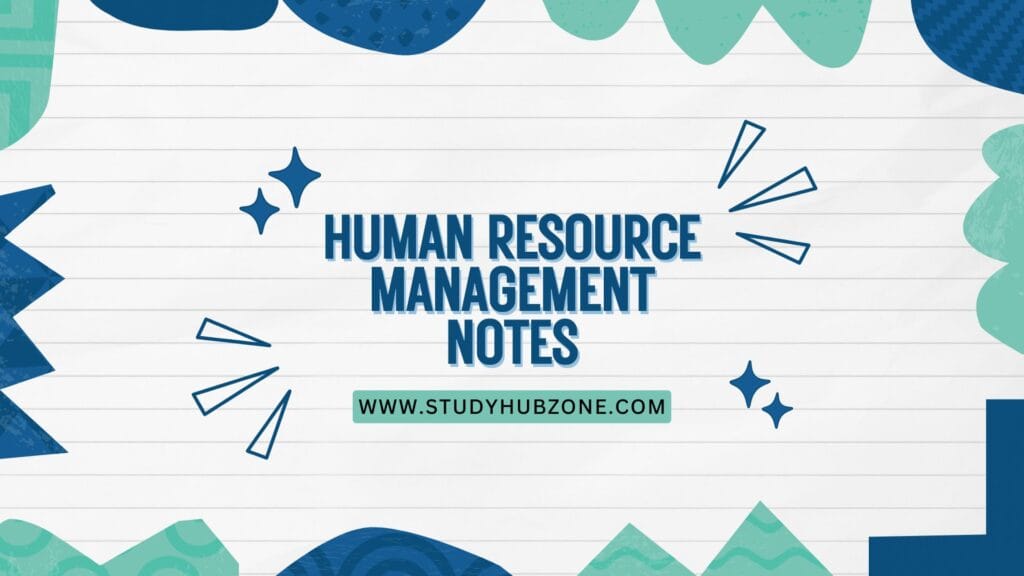
Are you looking for Human Resource Management Notes PDF to prepare for your exams? You’re in the right place! Whether you’re a BBA, B.Com, MBA, BA (HR/Management) student or preparing for competitive exams like NET, UGC, or HR certifications, these easy-to-understand, high-quality HRM notes are exactly what you need.
In this article, you’ll get:
Free downloadable PDF notes for each unit
Clear explanations in simple English
Topics covering the complete syllabus
Best study material for quick revision
Explore the units below for detailed content. Want’s to explore more subjects – Study Hub Zone
What is Human Resource Management?
Human Resource Management (HRM) is the strategic approach to managing people in an organization. It focuses on recruiting, developing, motivating, and retaining employees to achieve both individual and organizational goals. HRM is essential for building a positive workplace culture and driving performance.
These notes will help you understand key concepts such as:
Human resource planning and job analysis
Recruitment, selection, and training
Performance appraisal and compensation
Employee motivation and engagement
Industrial relations and labor laws
HRM in the digital age and strategic HR
Why Use Our HRM Notes?
👉 100% Syllabus Covered
👉 Designed for BBA/B.Com/MBA/HRM/UGC NET students
👉 Based on the Latest University & Corporate HR Practices
👉 Prepared by Experienced HR Professionals & Academics
👉 Perfect for Academic Exams, Viva, and HR Interviews
Download Human Resource Management Notes PDF – Unit Wise
Click on the download buttons below to get unit-wise HRM PDF notes. All files are free, secure, and optimized for both mobile and desktop use.
Course Units
Unit 1: Introduction to HRM and Human Resource Planning
Topics Covered: The definition, nature, scope, and objectives of Human Resource Management, its evolution from traditional to strategic HRM, comparison with personnel management, and detailed insights into Human Resource Planning (HRP), forecasting, and succession planning.
Unit 2: Job Analysis, Job Design, Recruitment, and Selection
Topics Covered: Focuses on the process and methods of job analysis, preparation of job descriptions and specifications, job design approaches like mechanistic and motivational, and recruitment sources along with the complete selection and induction process.
Unit 3: Training, Development, and Career Planning
Topics Covered: The need and methods of employee training (on-the-job and off-the-job), executive development programs, evaluation of training effectiveness, and processes related to career planning and development in organizations.
Unit 4: Performance Appraisal and Compensation Management
Topics Covered: Discusses performance appraisal techniques such as 360-degree feedback, MBO, and rating scales, along with components of compensation systems, monetary and non-monetary incentives, fringe benefits, and perks for employee motivation.
Unit 5: Industrial Relations and Emerging Trends in HRM
Topics Covered: Key aspects of industrial relations including grievance handling, employee discipline, and redressal systems, while highlighting emerging HRM trends like HR analytics, e-HRM, talent management, diversity, CSR, and ethical HR practices.
Final Thoughts
These Human Resource Management notes are carefully prepared for your academic success. Whether you’re revising before exams or trying to understand HRM concepts and practices, these unit-wise notes are all you need.
If you find these notes helpful, please share this page with your classmates and bookmark it for future use!
Share With Your Friends!
Found this post helpful? Share it with your classmates and peers who are preparing for Human Resource Management. Knowledge grows when shared!
Got Questions or Need Help?
If you have doubts or want other subject notes like Organizational Behavior, Industrial Relations, Talent Management, or Training and Development, let us know in the comments or contact us!
